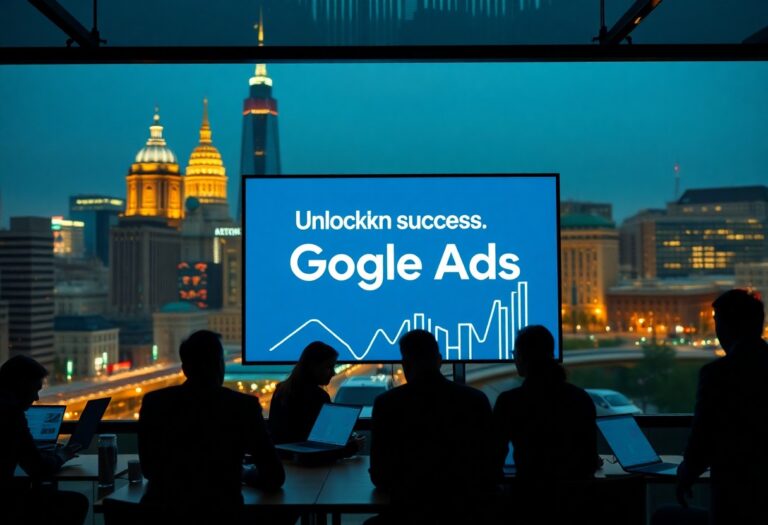Transform Your Online Presence – 6 Steps To Website Design In Cincinnati
Cincinnati, the Queen City, is not just about chili and baseball; it’s about transforming your online presence too! If you’re ready to…
Cincinnati, the Queen City, is not just about chili and baseball; it’s about transforming your online presence too! If you’re ready to take your website from drab to fab, you’ve clicked on the right post. I’m here to guide you through six easy steps that will not only enhance your site’s design but also boost your visibility in the bustling digital landscape. So, put on your thinking cap, and let’s probe the wonderful world of website design in the heart of Cincinnati!
Key Takeaways:
- Prioritize user experience by ensuring your website is easy to navigate, visually appealing, and optimized for different devices.
- Incorporate a clear and consistent branding strategy that reflects your business identity and resonates with your target audience.
- Utilize SEO best practices to enhance your website’s visibility on search engines, driving more organic traffic to your site.

Crafting Your Digital Identity: The Power of A Strategic Brand
Your online presence hinges on a strong brand identity that resonates with your audience. A strategic brand serves as the foundation for all your digital efforts, from design to content. It’s about creating a memorable feeling and connection with visitors who might be scrolling through countless websites. Engage them with a story that speaks loudly about who you are and what you offer, ensuring that every visual element and piece of text echoes your mission. By solidifying your brand identity, you’re not just building a site; you’re crafting a vibrant digital space that draws people in.
Defining Your Brand Voice and Aesthetic
Establishing a distinct brand voice and aesthetic is non-negotiable. Whether your tone is playful, formal, or somewhere in between, it should reflect your business’s personality. The colors, fonts, images, and language you choose convey your message long before anything is written or said. I suggest looking to brands that inspire you and analyzing their approach. Are they quirky and breezy, or sleek and corporate? Find your angle, hone it, and watch how it transforms your digital narrative.
Aligning Your Website with Your Brand’s Mission
A website is more than just a digital business card; it’s a reflection of your brand’s mission and values. Aligning your site with these elements fosters trust and connection. This ensures visitors feel at home the moment they land on your page. Think of your mission statement as your guiding star; everything from your website’s layout to its content should echo that core purpose. When users can easily see how your products or services connect back to your values, they’re more likely to engage and convert.
Imagine a sustainable fashion brand whose mission is to reduce waste. Their website could feature earthy tones, minimalist design, and content that highlights eco-friendly practices. Intentional storytelling through blogs or customer testimonials reinforces that commitment. This alignment doesn’t just translate to pretty visuals; it builds a cohesive experience that resonates deeply with folks who share those values. By infusing your mission into every corner of your website, you create an inviting portal that feels authentic and inviting—and that’s a powerful draw for any digital visitor.
The User Experience Makeover: Designing for Engagement
Engagement is the heartbeat of any successful website. By revamping the user experience, I focus on creating a seamless journey for visitors that encourages interaction and connection. Enhanced interfaces, quick load times, and intuitive layouts keep users on the site longer and drive conversion rates up. Let’s not forget that optimal design not only captivates but also leads users naturally toward taking the desired action.
The Psychology of Navigation: Guiding Visitor Behavior
Navigation acts as the roadmap for your visitors, and a well-designed menu reduces friction in their journey. By categorizing content logically and using familiar icons, I guide users smoothly from point A to B, maximizing their satisfaction and keeping bounce rates low. Intuitive navigation doesn’t just improve user experience; it also makes the website a go-to place where visitors return time and again.
Mobile Optimization: Reaching the On-the-Go User
With more than half of web traffic coming from mobile devices, optimizing for mobile users isn’t merely beneficial; it’s a necessity. Streamlined layouts, readable fonts, and speedy loading times transform a cumbersome experience into one that flows effortlessly across devices, ensuring no one gets left behind.
To truly enhance mobile optimization, my focus includes responsive design that automatically adjusts for any screen size. Imagine a potential customer, rushing between meetings, effortlessly browsing your website without squinting at tiny text or pinching to zoom. Therefore, images must be optimized for quick loading, and buttons need to be large enough for easy navigation. Understanding your audience’s mobile habits can further refine the overall experience, ultimately transforming fleeting visits into lasting conversions.
Content that Converts: Writing for the Web
Writing for the web demands a unique approach that balances creativity with conversion. It’s not just about what you say, but how you say it. Crafting compelling content that keeps visitors engaged while driving them towards action can make or break your website’s effectiveness. Detailed product descriptions, insightful blog posts, and persuasive calls to action all play pivotal roles in persuading potential customers. Ensure your copy embodies your brand’s identity while seamlessly guiding the audience through their journey.
The Art of Engaging Copy: Hooking Your Audience
Engaging copy is all about grabbing attention and retaining interest. I often start with a provocative question or a relatable statement that resonates with my audience’s needs. The goal is to evoke an emotional response, creating a sense of connection right off the bat. Using *powerful verbs* and *vivid imagery* empowers your message and makes it memorable. Great copy is not just informative—it’s *inspiring*, prompting readers to act.
Visual Storytelling: Using Images to Enhance Messaging
Integrating imagery with your content transforms ordinary text into a compelling narrative. Images can encapsulate complex ideas and convey emotions quickly, transcending language barriers and catering to diverse audiences. Using relevant visuals not only makes your website more *appealing* but also aids in retention. Studies show that people remember 65% of information paired with images compared to just 10% when stated alone.
Effective visual storytelling marries *images with purpose*, aligning them with your written content. For instance, if you’re discussing a product, showcase high-quality images that highlight its features or usage in real-life scenarios. Infographics can distill complex information into easily digestible morsels, while *testimonials* with accompanying photos add authenticity to your claims. Consistent imagery that reflects your brand style strengthens recognition and builds trust, giving your audience a seamless experience that resonates long after they leave your site.
The Technical Backbone: Ensuring Your Site Runs Smoothly
Behind every stunning website lies a robust technical infrastructure that guarantees seamless functionality. A well-optimized site not only enhances the user experience but also boosts your search engine rankings. Implementing reliable hosting, fast-loading speeds, and mobile responsiveness are non-negotiable components. Without these technical elements in place, even the most beautifully designed sites can leave users frustrated, leading to higher bounce rates and lost opportunities. Let’s probe the specifics of how to get your site up and running efficiently.
Choosing the Right Platform: WordPress vs. Custom Solutions
WordPress offers a user-friendly entry point for many, with its vast library of plugins and themes that can streamline your site’s development. On the other hand, custom solutions can provide more tailored functionality and design flexibility, making them ideal for unique business needs. Ultimately, the choice boils down to whether you prefer the convenience of a well-trodden path or the freedom of forging your own.
SEO Fundamentals: Making Your Site Discoverable
Understanding the basics of SEO can dramatically increase your website’s visibility on search engines. Simple practices like optimizing title tags, using relevant keywords, and ensuring your site is mobile-friendly can have significant impacts. Regular updates to your content and multimedia elements also play a vital role in keeping search engines interested in your site.
Consider integrating tools like Google Analytics to track your site’s performance and identify areas for improvement. Developing a blog can help you consistently publish fresh content, naturally embedding important keywords. Aim for a balance between informative and engaging writing, which not only attracts visitors but also encourages them to share your content. Utilizing backlinks, optimizing your website speed, and deploying schema markup can further enhance discoverability. The journey to mastering SEO might be ongoing, but the rewards are plenty: increased traffic, leads, and ultimately, conversions.
Keeping It Fresh: The Importance of Ongoing Maintenance
No matter how stunning your website is at launch, it won’t remain attractive or functional without regular maintenance. Just like a garden, your online presence needs consistent care to flourish. I can’t stress enough the significance of routine updates, security checks, and adjustments to keep your site in line with the latest web standards. This proactive approach not only boosts your site’s performance but also enhances your users’ experience, keeping them coming back for more.
Regular Updates: Keeping Content Relevant
Updating your website content is non-negotiable; stale information is the digital equivalent of a dusty book. Adding fresh blogs, updating images, and keeping your product offerings current ensures that visitors see your site as a reliable resource. This tactic not only entices new visitors but also cultivates loyalty among returning ones who appreciate up-to-date content.
Performance Monitoring: Analyzing Metrics for Improvement
Performance monitoring helps track vital metrics that tell you what’s working and what’s not. By plunging into analytics, I can uncover how visitors interact with your site—such as page views, bounce rates, and conversion rates. These insights allow for data-driven decisions that enhance user experience and ultimately improve your site’s effectiveness.
Utilizing analytics tools like Google Analytics or Hotjar, I frequently assess user behavior patterns and traffic sources. For example, if I notice a high bounce rate on a specific page, it may signal that the content isn’t engaging or relevant enough, prompting me to make immediate adjustments. Regularly monitoring these metrics can reveal unexpected trends, such as a surge in mobile users; this information could guide a responsive redesign to optimize the mobile experience. Ultimately, understanding your data allows me to not just react, but to strategically evolve your website to meet ever-changing user expectations.
Final Words
Hence, as I wrap up this whirlwind tour of transforming your online presence in Cincinnati, it seems clear that a slick website isn’t just a pretty face—it’s your digital handshake! Dive into these six steps, tweak and twist them to fit your style, and you’ll be rolling out a site that not only wows but truly resonates with your audience. So go on, let your creativity run wild, and show the world what your brand is all about! Your online journey is just beginning, and trust me, it’s going to be a fun ride!
Q: What are the first steps in transforming my online presence through website design in Cincinnati?
A: The first steps involve understanding your goals and identifying your target audience. Begin by defining what you want your website to achieve, whether it’s generating leads, showcasing a portfolio, or selling products. Then, research your audience’s preferences and behaviors to tailor your website effectively. Afterward, create a sitemap to organize content, ensuring a logical flow of information that guides users through their experience.
Q: How important is responsive design in the website design process?
A: Responsive design is imperative in today’s digital landscape. With a growing number of users accessing websites via mobile devices, ensuring that your website looks and functions well on all screen sizes is paramount. A responsive design not only enhances user experience but also improves search engine rankings, as search engines prioritize mobile-friendly sites. By using responsive design, you ensure that visitors have a consistent experience, regardless of their device.
Q: What role does content play in the overall website design strategy?
A: Content is a vital component of website design. High-quality, engaging content helps convey your brand message and keeps visitors interested. It’s imperative to create clear, concise, and informative text, along with relevant images or videos. Additionally, incorporating SEO best practices into your content ensures that your site is discoverable by search engines. The right content not only attracts visitors but also fosters trust and encourages conversions, making it indispensable for a successful online presence.





